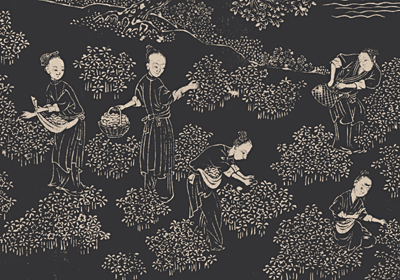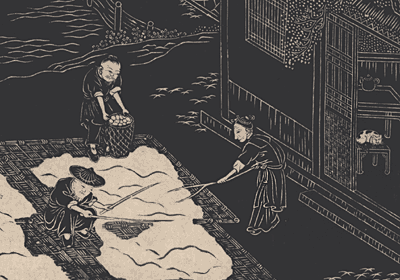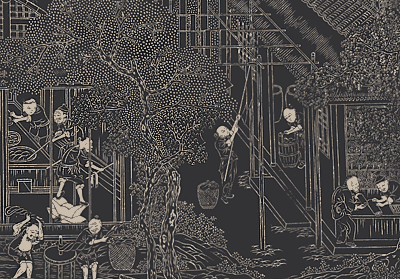China and Europe: 1500-1800
China: An "Early Modern" Society, Part 3
Anti-monopolists
Another good example of how we misinterpret Chinese history when we apply a Western framework concerns the Qing dynasty's attempts to prevent the emergence of monopolies in essential goods. The Qing government tried very hard to make sure that no one grain dealer obtained complete dominance over the local grain market because they knew what that could mean for consumers. As a result they devised a licensing system, which was designed to make sure that there were always multiple licensees in any given place. If you look at that in isolation, you can find a document that says so-and-so had his grain license taken away. And if you're caught in the old stereotype that the Chinese government hated commerce, you look at that and that appears to be evidence of an anti-commercial attitude. But if you look at it in the broader context, you say, "Oh no, they were not anti-commerce. They were anti-monopoly."
The Government Promotes Cotton [VIDEO]
TRANSCRIPT: Cotton, which becomes the major clothing material in China starting about 1350, is an interesting story in itself. Cotton is not native to China; it comes to China from India. And it spreads gradually over a period of roughly 500 years. In 1300 nobody in China wears cotton; by 1800, 1850 almost everybody does. And like any new crop, it took people a while to figure out how to use it, what to do with it, how to grow it. It needs different kind of land; it needs different kind of cultivation.
And knowledge spreads relatively slowly in a preindustrial world. And so while cotton is not introduced by the government—it's introduced by private actors just trying to do something a little bit better—eventually adapting it to other regions in China with different ecologies and people who aren't familiar with it does require government intervention. The government intervenes by providing seed, providing knowledge, printing little pamphlets, organizing lectures, and so forth.
Cotton is advantageous for a couple of reasons. One is (that) it's a lot less scratchy than hemp, which was one of the main clothing fibers before. It's also lighter and more comfortable, and it's also easier to work with. Spinning and weaving hemp or ramie, which were the other two predominant fabrics before—except for silk, which was largely for the rich—are both extremely difficult. And so the growth of the cotton economy is in part, only in part, but it is in part a labor-saving thing. It's just easier to work with. It takes enormous amount of time to prepare hemp for spinning, same for ramie. Cotton is easier.
And I emphasize that in part because again we have this stereotype of China, in which we think there are so many Chinese that there's always sort of chronic under- and unemployment. And that, in fact, in some people's stories, that's one of the reasons China doesn't industrialize. They say, "Aha, with too many people, labor becomes too cheap. And if labor is too cheap there's no incentive to mechanize." Well, there are times and places in China where there is this kind of chronic underemployment. Just as there is in early modern Europe, in India, in all sorts of other places.
But there are also times and places of serious labor shortage. And periods in which people are taking what we might think of as this very "modern" economic attitude of: How do I save labor? How do I save time? Would it make sense for a family to spend a little bit more on buying soy sauce rather than making it at home? And having the wife, instead of spending her time making the soy sauce, use that extra time to do the thing that she can earn more money at, which is making more cotton cloth and selling it to get the money with which you buy the soy sauce.
One important exception to this is the government monopoly on salt. Various Chinese regimes going back centuries found salt taxes an irresistible revenue source. Salt was an essential nutrient that you can only produce in selected areas, and so it was relatively easy to control and to raise the price. In fact, many premodern regimes find salt to be a crucial source of funds and monopolize it.
On the whole, however, the Qing government encouraged competition and made sure that there were multiple grain dealers so that nobody could do the sorts of things that monopolists do. There were a whole series of regulatory efforts as well as educational efforts to teach people how to weave, spin, and grow cotton, and how to market their products. The government also built emergency granaries and maintained public order to ensure that grain moved back and forth.
All these are ways in which the Qing were very good at exploiting the possibilities that they could see within a premodern economy. They never envisaged getting out of that premodern economy and suddenly getting into a world in which you used vastly increased quantities of energy, invented loads of new products and production processes, and did the things that we did in the nineteenth and twentieth centuries. But we shouldn't be shocked that they didn't envision that: nobody else did either. It came upon people as a surprise when it happened. It's only in looking back from today that nineteenth-century technology-driven growth appears to follow from a very different kind of premodern growth, largely driven by increased trade, labor, power, et cetera, within an environment of very limited technological change.
Illustrations of Cotton Cultivation and Manufacture Presented to the Qianlong Emperor and Used by Government Officials to Instruct Farmers
C. V. Starr East Asian Library, Columbia University

Picking Cotton

Selecting and drying cotton in the sun.

Weaving cotton cloth.

Drying cotton cloth.